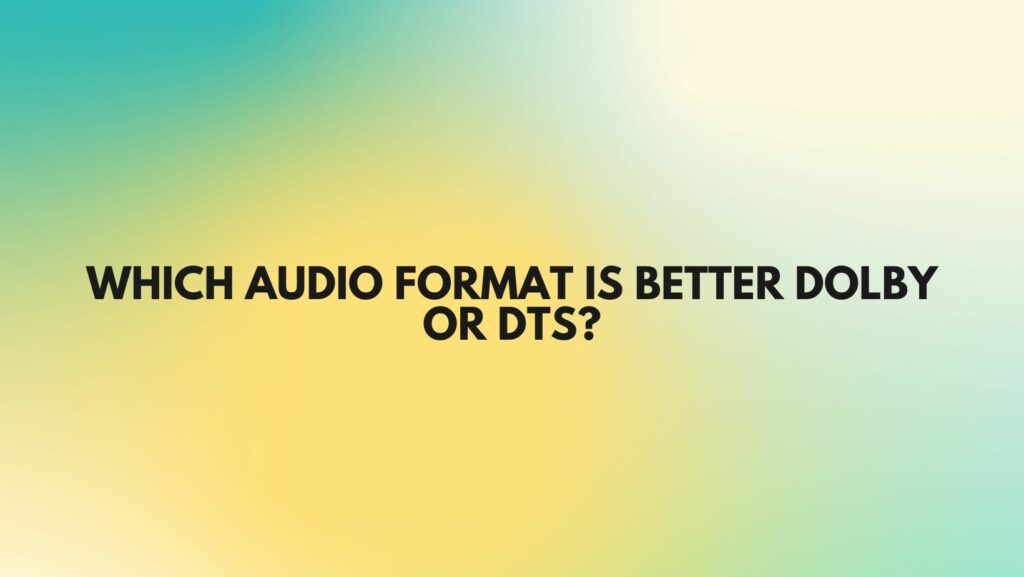In the realm of audio technology, the choice between Dolby and DTS has been a long-standing debate among enthusiasts and home theater aficionados. Both Dolby and DTS (Digital Theater Systems) are prominent audio formats, each with its strengths and characteristics. In this article, we will delve into the intricacies of Dolby and DTS, aiming to shed light on the question of which audio format reigns supreme.
Dolby: A Pioneer in Audio Innovation
Dolby has been at the forefront of audio innovation for decades, introducing groundbreaking technologies that have become industry standards. Dolby Digital, Dolby TrueHD, and Dolby Atmos are among the notable formats that have shaped the audio landscape.
- Dolby Atmos – Immersive 3D Audio:
- Dolby Atmos, a revolutionary 3D audio technology, stands out as one of Dolby’s crowning achievements. It introduces a height element to sound, allowing audio to move freely in a three-dimensional space. This innovation has transformed the way we experience movies, music, and gaming.
- Dolby TrueHD – Lossless Audio Quality:
- Dolby TrueHD is a high-definition audio format known for its lossless compression, delivering audio without any degradation in quality. It is often the choice for audiophiles seeking the most authentic and detailed sound reproduction.
DTS: A Rivalry in Sonic Excellence
Digital Theater Systems (DTS) has been a significant player in the audio industry, providing an alternative to Dolby’s offerings. DTS:X and DTS-HD Master Audio are key formats associated with DTS.
- DTS:X – Competing in the 3D Audio Arena:
- DTS:X is the response to Dolby Atmos, offering an immersive 3D audio experience. Like Atmos, DTS:X enables sounds to move freely around the listener, creating a captivating audio environment. It competes directly with Dolby Atmos in terms of spatial audio innovation.
- DTS-HD Master Audio – Uncompressed Brilliance:
- DTS-HD Master Audio is DTS’s counterpart to Dolby TrueHD, providing a lossless audio format that preserves the original sound quality. It is favored for its ability to deliver high-fidelity audio in a compressed format, making it suitable for various entertainment mediums.
Choosing Between Dolby and DTS:
- Content Availability:
- Both Dolby and DTS formats are widely supported in the entertainment industry. The availability of content in a specific format might influence your choice, especially when considering movies, music, or gaming preferences.
- Compatibility and Device Support:
- Consider the compatibility of your playback devices. While most modern home theater equipment supports both Dolby and DTS, it’s essential to ensure that your chosen format aligns with your devices for seamless playback.
- Personal Preference and Subjective Experience:
- The “better” audio format ultimately depends on personal preference. Some users might prefer the spatial innovation of Dolby Atmos, while others appreciate the sonic excellence of DTS:X. Consider your priorities in terms of audio quality, immersive experience, and content variety.
Conclusion:
The choice between Dolby and DTS is akin to selecting between two symphonies, each with its unique melodies and harmonies. Both audio formats have contributed significantly to elevating the audio experience in home entertainment. Whether you find yourself enchanted by the immersive heights of Dolby Atmos or captivated by the brilliance of DTS-HD Master Audio, the world of audio continues to evolve, providing enthusiasts with a symphony of options to tailor their sonic journey. Ultimately, the “better” format is a subjective choice, and the true winner lies in the ears of the beholder.


